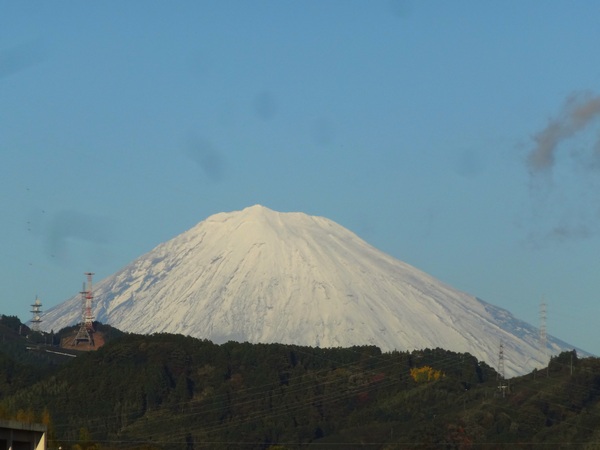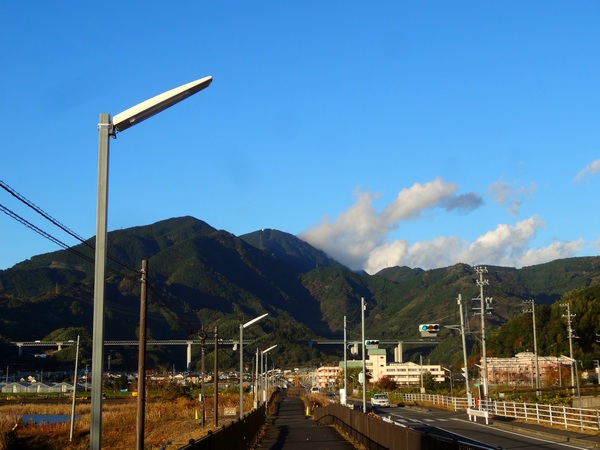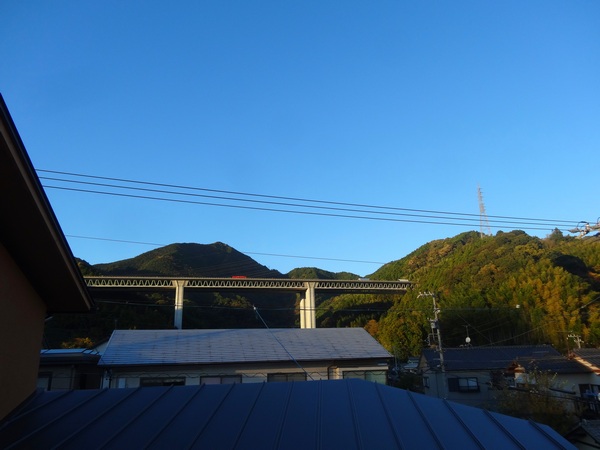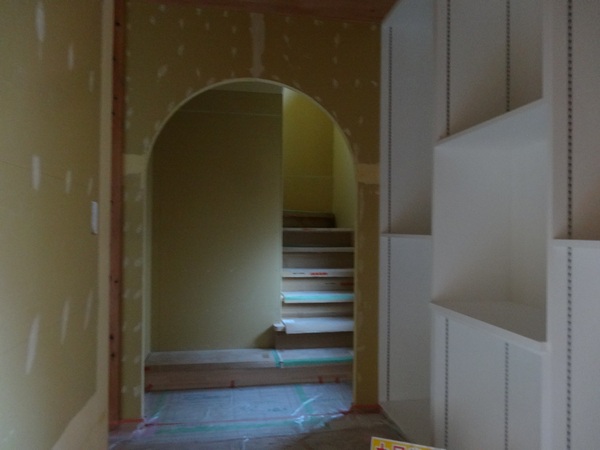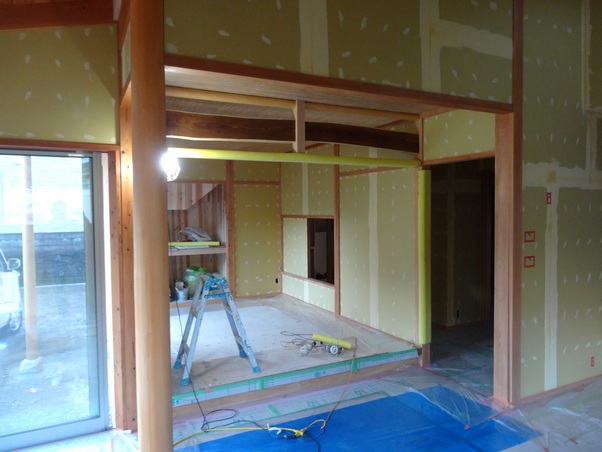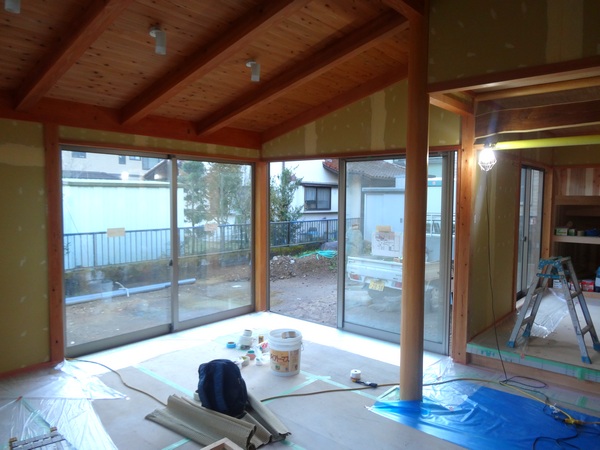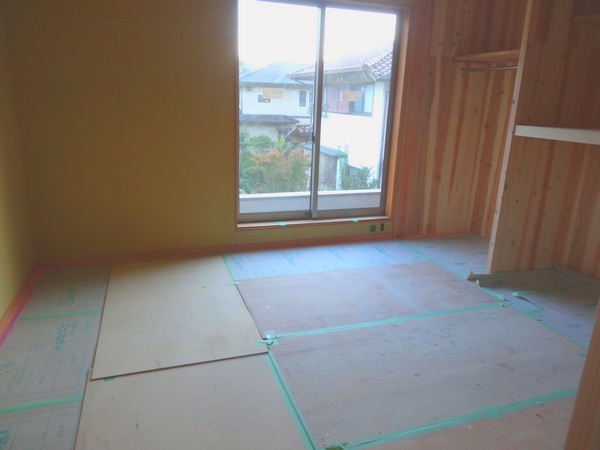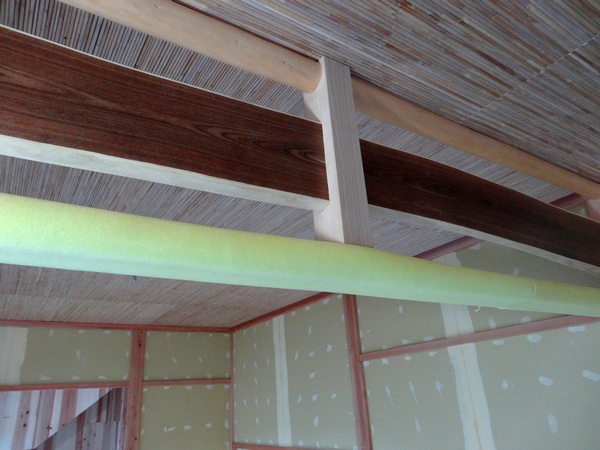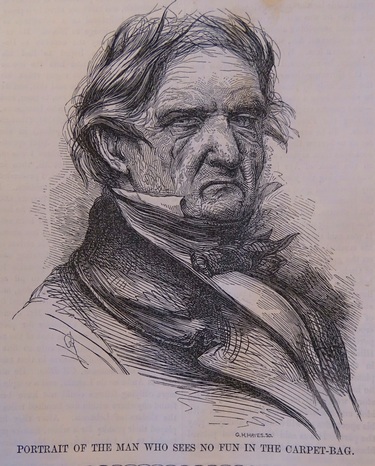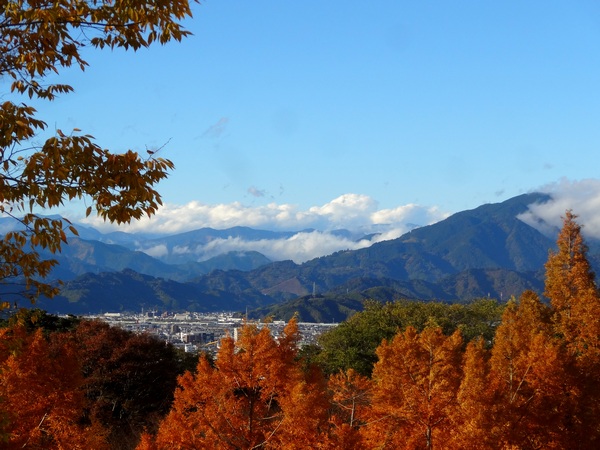 Here we are high on the campus of Shizuoka University, a few steps from Steve’s office. More or less we’re looking north across the plain of Shizuoka City and toward the mountains. In the above photograph, you can’t see our beloved Ryuso Mountain, but it’s just outside the right side of the frame. It’s there, trust me.
Here we are high on the campus of Shizuoka University, a few steps from Steve’s office. More or less we’re looking north across the plain of Shizuoka City and toward the mountains. In the above photograph, you can’t see our beloved Ryuso Mountain, but it’s just outside the right side of the frame. It’s there, trust me.
If you look as deep as you can into that city development, at the bit turning slightly right (in order to better nestle into the mountains), you will be looking at the neighborhood known as Kita (literally, “North”).
Yes, yes, I hope this won’t upset you, but we have been on a long, long journey north, and now we are almost there. Makes me recall a stanza from the work of that visionary poet, Jackson Freefrock.
That’s the north, is it?
Well, shall we go and make our visit?
Steve! hold on! What’s this “we” you keep using? Who are you building this house with? Who is helping you pay for it?
The first question first. This “we.”
Believe me, I know all about that other word, the word I.
I am, for example, deeply in love with the way that Thoreau begins Walden:
In most books, the I, or first person, is omitted; in this it will be retained; that, in respect to egotism, is the main difference. We commonly do not reember that it is, after all, always the first person that is speaking. I should not talk so much about myself if there were any body else whom I knew as well. Unfortunately, I am confined to this theme by the narrowness of my experience. Moreover, I, on my side, require of every writer, first or last, a simple and sincere account of his own life, and not merely what he has heard of other men’s lives; some such account as he would send to his kindred from a distant land; for if he has lived sincerely, it must have been in a distant land to me.
But more than this “I,” I am, as the house construction comes to an end, feeling this “we, we, we.” (Wait—we, we, we!—that’s what one of the little piggies said, isn’t it!)
And you don’t think that old Henry raised his Walden Pond cabin by himself, do you? And you do know that he didn’t build it on his own land? And you do know that much of his solitude in the woods as a young man was spent with that older Emerson guy?
Well, about the money, no one is helping me pay for the house. And the only person’s name on the contract is mine. But I could have never gotten to this point without a hell of a lot of help. If it weren’t for the all the support from the Hearty Hikers, I would have never had the courage to press my inked-up seal on to the contract paper in the first place.
And I didn’t build anything. I had a great architect, a great carpenter, a great construction team build the house. Sure, I did a little bit of painting, fretted over the details, combed the pages and pages of the estimate looking for ways to save money (the builder himself was surprised that I found cheaper and better all-wood doors on the Internet), but still I didn’t build anything. Although I guess you could say that they couldn’t have built the house without me.
The architect, the head carpenter, the boss at the construction company, and I are all almost the same age. This has been a great thing.
But as we stand here on the balcony of the Humanities Building, looking across the city, I guess what I feel most when I use the word we, is . . . we means “All the Hearty Hikers inside of me and all around me, all the Hearty Hikers I’ve ever hiked with—and all the Hearty Hikers I ever will hike with.” If you’re not yet a Hearty Hiker, I hope you’ll consider becoming one. Then it will be your house, too.
Let me say this clearly: I love my Hearty Hikers buddies.
They taught me this: Sometimes you have to do things by yourself, but if you have the Hearty Hikers spirit, it is impossible to ever be alone.
This is a great thing. So . . . let’s go and make our visit.
On a bicycle, it’ll take you about forty-five minutes. Be sure to check out the scenery along the way.
It’s not bad.
After you cross under the Tomei Expressway, you’ll see the Children’s Hospital up ahead on the right.
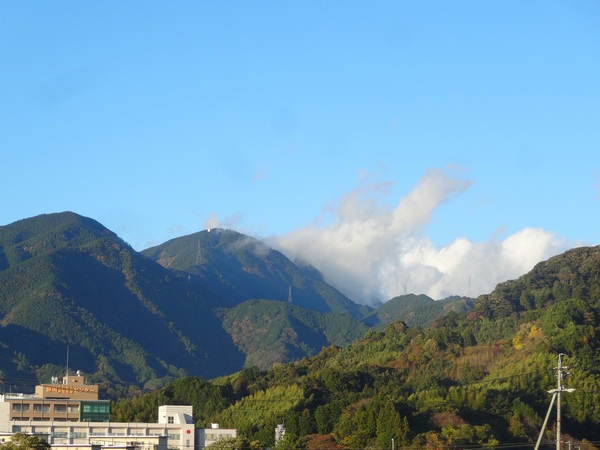 There it is nestled in the bottom left corner of this photo. The rounded peak with the mysterious white something-or-other on top is Ryuso. You feel better now, right?
There it is nestled in the bottom left corner of this photo. The rounded peak with the mysterious white something-or-other on top is Ryuso. You feel better now, right?
Now we’ve turned right. We’ve just gone by the hospital. We can see the Shin Tomei Expressway clearly. Our house is not far from it. Yep, you can still see Ryuso.
And now the scaffolding has been taken away, so you can go up to the second floor, go out on the balcony, step up onto the living room roof, and peer out at the Shin Tomei . . . and of course, Ryuso. It looks smaller from this angle but actually it’s the tallest of all you can see. It’s directly above the giant expressway pillar on the right side.
Yes, yes, mountains look different with every step you take.
Okay, shall we go back outside and begin the formal tour.
Yes, our baby’s braces have been taken off—and . . . indeed! it’s a house! Yesterday, I did the conversions. In Japanese, it’s about 35 tsubo. In square feet, it comes to somewhere around 1100. Not so big, some of you may think. But we Hearty Hikers are a friendly bunch. When things are snug, everyone is warm. (Yeah, yeah, the summers are hot and humid.)
In the front door we go. We’ll step in, then step up. That’s a shoe box in mid-construction on the right. Yes, all Japanese homes have a shoe box by the entrance, the genkan. The sign at the bottom, only the tip of which you can see, says “No shoes!” Yeah, not even during construction! The stairs obviously lead upstairs. You can’t see it, but just before the arch, on the left, is a hallway. It will take you to the main room, the living-dining-kitchen single space. Standing here, I’m again reminded of Freefrock.
A noble Roman arch, is it—
Inviting us to make our visit?
Now we’ve come through that door frame on the right, and we are standing in the middle of the living room. Through the glass, on the left, you can see the small space where the first-floor veranda will go in. (Sit out and have a cup of coffee with a friend or two size.) The kitchen is to the right. Straight ahead is the tatami-mat room. No tatami yet. (But we visited the little factory where tatami is made to make sure we were getting something that would make us happy.)
Inside the tatami room, you’ll see something that looks like a window. It is a window. A window opening up to the hallway. If you’re standing at the front entrance, and look through that window, you can see through the tatami room, through the living room, through the non-rectangular quadrilateral window on the far side of the living room, and up at the mountains. When I first saw that view, I thought I’d cry. The architect said he hadn’t thought the design through that much. And so it goes. 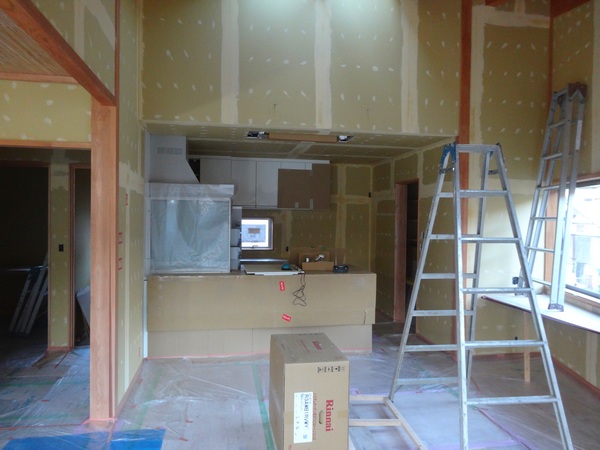 And here’s our kitchen. On the right, you can see the little counter-desk we waxed a while back, and behind that, the door to the pantry. The cabinet/pantry space exceeds that of my current apartment by a mere 3000 percent.
And here’s our kitchen. On the right, you can see the little counter-desk we waxed a while back, and behind that, the door to the pantry. The cabinet/pantry space exceeds that of my current apartment by a mere 3000 percent.
And from the same spot, looking out toward the garden. More on the garden another time.
Here’s looking at the living room space, tatami-mat room on the right, while standing at the kitchen sink. There is a counter in the kitchen that can be used for cooking. Very convenient. My current apartment has no counter space. Thus, as all you mathematicians know, not much sense in trying to calculate the percentage increase.
Here we are standing out in the backyard, looking in. Yes, we’re getting ready to paint. And we are beginning to imagine some nice evenings here, Hearty Hikers maybe sharing a glass of wine and talking about all sorts of cool stuff. Again, Freefrock comes to mind.
The hearty hikers come and go,
Talking of how persimmons glow!
Now we’re upstairs in the only bedroom. There’s also a small “study” upstairs that could become a bedroom if it needs, too. Besides the oshi-ire (“closet”) space you see on the right, there’s also a walk-in closet. A trap door inside the walk-in closet leads to a “secret” room that I can’t tell you about it because it’s a secret.
Yep, there’s a toilet upstairs. And one downstairs, too. Two toilets. Enough for even the richest of kings living in the greatest of luxury. Some people might say two times what’s necessary. . . . But we’re getting offtrack.
Wait a minute! you suddenly exclaim. When we were downstairs, did I notice that part of your ceiling was made of STRAW? Don’t you know what happened to the first little pig’s house?
Indeed, I do. But the big, bad wolf blew that house down from outside. This straw is on the inside.
But what if he got inside?
If he got inside and wanted to try to blow this ceiling up through the second floor and out the roof, and into the blue sky, and all the way over the Shin Tomei Expressway, and all the way over Ryuso Mountain, and all the way over dear friend Fuji’s head . . . and all the way out of this universe, I guess I’d dare him to try.
But all joking side, you say, for all this talk of Hearty Hikers and that joyous spirit of comradery, what would you do, if suddenly the Big, Bad Wolf did show up, did want to crash the party? Would you let him in?
. . .
Now we’ve come to a perplexing question. And to be honest, I’m not sure of the answer.
But by happenstance, I did meet the Big, Bad Wolf this past March. I spotted him inside a carpet bag.
Yes, indeed. I had secluded myself in a New England library, one on the campus of a somewhat famous university. Outside snow was all around and the sky was a brilliant blue, but inside I was deep inside the 19th Century, reading through the original weekly issues of The Carpet-Bag from 1851 to 1852. That’s some pretty old newspaper to still be in good reading shape.
I was investigating, more or less, the way in which fiction writers were influenced by popular newspapers. The editors of The Carpet-Bag were a warm-hearted bunch, full of “cheerfulness,” as they self-described themselves, and hoped, in a jovial sort of way, to provide encouragement and good cheer to as many people as they could.
That strikes me as a good thing to have wanted to do.
But some folks didn’t like their cheerfulness—and in one issue they printed a picture of one man in particular that they knew didn’t like their publication. When I looked at the picture, I knew immediately who it was. It was the Big, Bad Wolf.
So what would I do if he showed up at my door, if he said to me, you better let me in to chastise you and your simpleton Hearty Hikers friends, or I’ll have your visa revoked, and I’ll buy this rotten persimmon for a farthing, and burn it down to the ground just for fun.
Hmmh.
No, I don’t think I’d let him in. Not right away.
But I wouldn’t shoot him, either.
Maybe I’d take him out in the garden, tell him where I was going to plant the kumquats, where the maples, where the persimmons. Maybe I’d have him sit down on one of the big rocks, maybe tell him that if we sat there until morning, we could see the sun come over the mountain, see the blue envelop the “persimmon.” Maybe then he’d see that the “persimmon” wasn’t rotten at all, that the “persimmon” was glowing.
But he’s the BIG, BAD WOLF!
I don’t care who he is. That’d be about all I could do.
I think.
But he hasn’t actually shown up, so I can’t really say.
